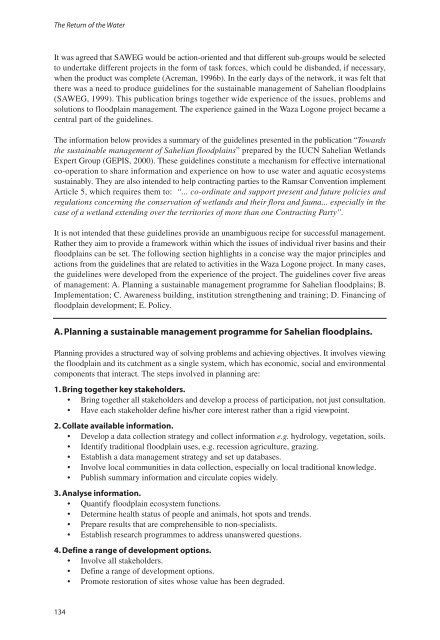The return of the water - IUCN
The return of the water - IUCN
The return of the water - IUCN
You also want an ePaper? Increase the reach of your titles
YUMPU automatically turns print PDFs into web optimized ePapers that Google loves.
<strong>The</strong> Return <strong>of</strong> <strong>the</strong> Water<br />
It was agreed that SAWEG would be action-oriented and that different sub-groups would be selected<br />
to undertake different projects in <strong>the</strong> form <strong>of</strong> task forces, which could be disbanded, if necessary,<br />
when <strong>the</strong> product was complete (Acreman, 1996b). In <strong>the</strong> early days <strong>of</strong> <strong>the</strong> network, it was felt that<br />
<strong>the</strong>re was a need to produce guidelines for <strong>the</strong> sustainable management <strong>of</strong> Sahelian floodplains<br />
(SAWEG, 1999). This publication brings toge<strong>the</strong>r wide experience <strong>of</strong> <strong>the</strong> issues, problems and<br />
solutions to floodplain management. <strong>The</strong> experience gained in <strong>the</strong> Waza Logone project became a<br />
central part <strong>of</strong> <strong>the</strong> guidelines.<br />
<strong>The</strong> information below provides a summary <strong>of</strong> <strong>the</strong> guidelines presented in <strong>the</strong> publication “Towards<br />
<strong>the</strong> sustainable management <strong>of</strong> Sahelian floodplains” prepared by <strong>the</strong> <strong>IUCN</strong> Sahelian Wetlands<br />
Expert Group (GEPIS, 2000). <strong>The</strong>se guidelines constitute a mechanism for effective international<br />
co-operation to share information and experience on how to use <strong>water</strong> and aquatic ecosystems<br />
sustainably. <strong>The</strong>y are also intended to help contracting parties to <strong>the</strong> Ramsar Convention implement<br />
Article 5, which requires <strong>the</strong>m to: “... co-ordinate and support present and future policies and<br />
regulations concerning <strong>the</strong> conservation <strong>of</strong> wetlands and <strong>the</strong>ir flora and fauna... especially in <strong>the</strong><br />
case <strong>of</strong> a wetland extending over <strong>the</strong> territories <strong>of</strong> more than one Contracting Party”.<br />
It is not intended that <strong>the</strong>se guidelines provide an unambiguous recipe for successful management.<br />
Ra<strong>the</strong>r <strong>the</strong>y aim to provide a framework within which <strong>the</strong> issues <strong>of</strong> individual river basins and <strong>the</strong>ir<br />
floodplains can be set. <strong>The</strong> following section highlights in a concise way <strong>the</strong> major principles and<br />
actions from <strong>the</strong> guidelines that are related to activities in <strong>the</strong> Waza Logone project. In many cases,<br />
<strong>the</strong> guidelines were developed from <strong>the</strong> experience <strong>of</strong> <strong>the</strong> project. <strong>The</strong> guidelines cover five areas<br />
<strong>of</strong> management: A. Planning a sustainable management programme for Sahelian floodplains; B.<br />
Implementation; C. Awareness building, institution streng<strong>the</strong>ning and training; D. Financing <strong>of</strong><br />
floodplain development; E. Policy.<br />
A. Planning a sustainable management programme for Sahelian floodplains.<br />
Planning provides a structured way <strong>of</strong> solving problems and achieving objectives. It involves viewing<br />
<strong>the</strong> floodplain and its catchment as a single system, which has economic, social and environmental<br />
components that interact. <strong>The</strong> steps involved in planning are:<br />
1. Bring toge<strong>the</strong>r key stakeholders.<br />
• Bring toge<strong>the</strong>r all stakeholders and develop a process <strong>of</strong> participation, not just consultation.<br />
• Have each stakeholder define his/her core interest ra<strong>the</strong>r than a rigid viewpoint.<br />
2. Collate available information.<br />
• Develop a data collection strategy and collect information e.g. hydrology, vegetation, soils.<br />
• Identify traditional floodplain uses, e.g. recession agriculture, grazing.<br />
• Establish a data management strategy and set up databases.<br />
• Involve local communities in data collection, especially on local traditional knowledge.<br />
• Publish summary information and circulate copies widely.<br />
3. Analyse information.<br />
• Quantify floodplain ecosystem functions.<br />
• Determine health status <strong>of</strong> people and animals, hot spots and trends.<br />
• Prepare results that are comprehensible to non-specialists.<br />
• Establish research programmes to address unanswered questions.<br />
4. Define a range <strong>of</strong> development options.<br />
• Involve all stakeholders.<br />
• Define a range <strong>of</strong> development options.<br />
• Promote restoration <strong>of</strong> sites whose value has been degraded.<br />
134












